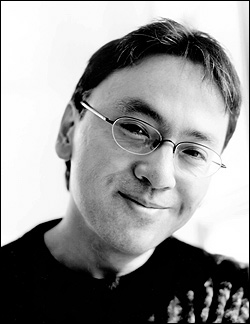It’s been more than 10 years since Kazuo Ishiguro dreamed up some characters who lived in cottages, argued about books, and pondered life’s possibilities. “I didn’t know who these people were at the time,” the 50-year-old London author explained in a recent telephone conversation. “I called them students, but there wasn’t a university.” It was only after hearing news and discussion programs about biotechnology that these English boarding-school pupils became clones raised for spare parts in his latest novel, Never Let Me Go (Knopf, $25).
To label the book as mere sci-fi, however, doesn’t do it justice. While the lives of 31-year-old Kathy and her friends Ruth and Tommy may seem worlds away from our reality, their story is relevant to anyone who’s ever sheltered children from truth, believed they could be saved by love, or simply tried to make sense of their lives. In flashbacks and memories to her school days in the late ’90s, narrator Kathy gradually pieces together the mystery of her own predetermined existence, with the reader supplying the contemporary context of cloning and genetic engineering.
Ishiguro, whose friends call him Ish, uses biotechnology only as a metaphor for talking about the human universal condition. “We try not to look too much at the fact that at some point we will lose control of our bodies and die,” he says, “but whether we openly face that or not, our priorities are set against that kind of background.”
The biggest challenge of his sixth novel, he says, was to connect with readers—no matter how far-fetched the plot. “It’s the same with all stories, I find. You can put these things down as ideas in a novel, but that’s not worth very much unless you can create situations that really reverberate with people at an emotional level.”
Through Kathy, he does just that. She recalls how her Halisham school guardians taught their pupils how crucial their well-being was to society. The students’ ultimate mission, however, was only revealed to them slowly, just as it is to readers who follow their progression to “carers” and then, like those they care for, “donors.” Kathy now takes pride in her job, gently steering her patients through even their fourth donation, which is typically when donors “complete.”
While their lives are more abbreviated than most, anyone who has cared for a dying relative, in the process being reminded of their own mortality, will identify. It’s the sort of connection that Ishiguro has been making for over 20 years.
YET Despite his prior literary achievements, including his Booker Prize–winning international best-seller The Remains of the Day, it was songs, not novels, that motivated the former church choir soprano to begin songwriting at 15 (he continued performing music into his early 20s). When his demos weren’t a hit with record companies, he applied to a postgraduate creative-writing program. “It seemed to be actually very little work,” Ishiguro says. “You had to produce 30 pages of fiction in 12 months to get your M.A., rather than some sort of dissertation. I thought this was very appealing.”
After gaining acceptance, a panicked Ishiguro rented a cottage in Cornwall. “For a month I sat there teaching myself to write short stories so I wouldn’t disgrace myself when I went to university.” Within the year, those stories were published in magazines and anthologies, and Faber & Faber had given him an advance and a contract for his first novel, the 1982 A Pale View of Hills. “It’s like a lot of things,” he says. “You try to succeed in one world, and nothing happens. You almost casually try in a slightly different one, and all the doors open very rapidly.”
After completing his current U.S. book tour, Ishiguro plans on finishing his next project, a collection of interrelated short stories. He adds, “I think the stories will all feature not-so-successful, itinerant musicians and be set in post–Cold War Europe.”
For now, Ishiguro says of Never Let Me Go, “Either consciously or unconsciously, depending on how much [readers] analyze it, I want it to reverberate with [them] as a very familiar experience. Everything these people are going through, I want people to think, ‘Well, that’s what I’ll be going through,’ or, ‘That’s what I do go through.'”
Kazuo Ishiguro will appear at Seattle Public Central Library, 1000 Fourth Ave., 206- 624-6600, 7 p.m. Tues., April 26.




